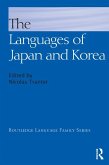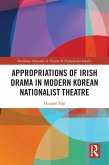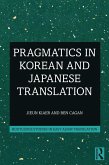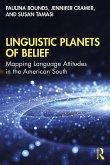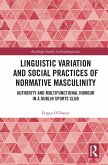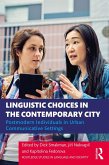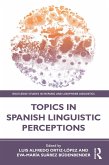37,95 €
37,95 €
inkl. MwSt.
Sofort per Download lieferbar

19 °P sammeln
37,95 €
Als Download kaufen

37,95 €
inkl. MwSt.
Sofort per Download lieferbar

19 °P sammeln
Jetzt verschenken
Alle Infos zum eBook verschenken
37,95 €
inkl. MwSt.
Sofort per Download lieferbar
Alle Infos zum eBook verschenken

19 °P sammeln
- Format: ePub
- Merkliste
- Auf die Merkliste
- Bewerten Bewerten
- Teilen
- Produkt teilen
- Produkterinnerung
- Produkterinnerung

Bitte loggen Sie sich zunächst in Ihr Kundenkonto ein oder registrieren Sie sich bei
bücher.de, um das eBook-Abo tolino select nutzen zu können.
Hier können Sie sich einloggen
Hier können Sie sich einloggen
Sie sind bereits eingeloggt. Klicken Sie auf 2. tolino select Abo, um fortzufahren.

Bitte loggen Sie sich zunächst in Ihr Kundenkonto ein oder registrieren Sie sich bei bücher.de, um das eBook-Abo tolino select nutzen zu können.
A Linguistic Image of Womanhood in South Korea examines the verbal and non-verbal techniques used by contemporary South Korean women to navigate their society.
- Geräte: eReader
- ohne Kopierschutz
- eBook Hilfe
- Größe: 2.26MB
Andere Kunden interessierten sich auch für
![The Languages of Japan and Korea (eBook, ePUB) The Languages of Japan and Korea (eBook, ePUB)]() The Languages of Japan and Korea (eBook, ePUB)46,95 €
The Languages of Japan and Korea (eBook, ePUB)46,95 €![Appropriations of Irish Drama in Modern Korean Nationalist Theatre (eBook, ePUB) Appropriations of Irish Drama in Modern Korean Nationalist Theatre (eBook, ePUB)]() Hunam YunAppropriations of Irish Drama in Modern Korean Nationalist Theatre (eBook, ePUB)42,95 €
Hunam YunAppropriations of Irish Drama in Modern Korean Nationalist Theatre (eBook, ePUB)42,95 €![Pragmatics in Korean and Japanese Translation (eBook, ePUB) Pragmatics in Korean and Japanese Translation (eBook, ePUB)]() Jieun KiaerPragmatics in Korean and Japanese Translation (eBook, ePUB)38,95 €
Jieun KiaerPragmatics in Korean and Japanese Translation (eBook, ePUB)38,95 €![Linguistic Planets of Belief (eBook, ePUB) Linguistic Planets of Belief (eBook, ePUB)]() Paulina BoundsLinguistic Planets of Belief (eBook, ePUB)39,95 €
Paulina BoundsLinguistic Planets of Belief (eBook, ePUB)39,95 €![Linguistic Variation and Social Practices of Normative Masculinity (eBook, ePUB) Linguistic Variation and Social Practices of Normative Masculinity (eBook, ePUB)]() Fergus O'DwyerLinguistic Variation and Social Practices of Normative Masculinity (eBook, ePUB)42,95 €
Fergus O'DwyerLinguistic Variation and Social Practices of Normative Masculinity (eBook, ePUB)42,95 €![Linguistic Choices in the Contemporary City (eBook, ePUB) Linguistic Choices in the Contemporary City (eBook, ePUB)]() Linguistic Choices in the Contemporary City (eBook, ePUB)34,95 €
Linguistic Choices in the Contemporary City (eBook, ePUB)34,95 €![Topics in Spanish Linguistic Perceptions (eBook, ePUB) Topics in Spanish Linguistic Perceptions (eBook, ePUB)]() Topics in Spanish Linguistic Perceptions (eBook, ePUB)38,95 €
Topics in Spanish Linguistic Perceptions (eBook, ePUB)38,95 €-
-
-
A Linguistic Image of Womanhood in South Korea examines the verbal and non-verbal techniques used by contemporary South Korean women to navigate their society.
Dieser Download kann aus rechtlichen Gründen nur mit Rechnungsadresse in A, B, BG, CY, CZ, D, DK, EW, E, FIN, F, GR, HR, H, IRL, I, LT, L, LR, M, NL, PL, P, R, S, SLO, SK ausgeliefert werden.
Produktdetails
- Produktdetails
- Verlag: Taylor & Francis eBooks
- Seitenzahl: 136
- Erscheinungstermin: 30. Dezember 2022
- Englisch
- ISBN-13: 9781000826685
- Artikelnr.: 66893449
- Verlag: Taylor & Francis eBooks
- Seitenzahl: 136
- Erscheinungstermin: 30. Dezember 2022
- Englisch
- ISBN-13: 9781000826685
- Artikelnr.: 66893449
- Herstellerkennzeichnung Die Herstellerinformationen sind derzeit nicht verfügbar.
Jieun Kiaer is Professor of Korean Linguistics at the University of Oxford. She publishes widely on East Asian linguistics, with particular emphasis on pragmatics. Her recent publications include Understanding Korean Film: A Cross-Cultural Perspective (with Loli Kim, 2021), More Than Polite (Routledge, forthcoming), and Pragmatic Particles: Findings from Asian Languages (2020).
Jiyoung Shin is Professor of Korean Linguistics at Korea University. Her research areas are phonetics and phonology, spoken grammar of Korean, and the role of prosody in subareas of linguistics. She is also interested in the ideology behind language. Shin has most recently published The Tug-of-War of the Language (2018) and The High Jump of Language (2021). She received the Presidential Commendation for her contributions to family policy in 2020.
Jiyoung Shin is Professor of Korean Linguistics at Korea University. Her research areas are phonetics and phonology, spoken grammar of Korean, and the role of prosody in subareas of linguistics. She is also interested in the ideology behind language. Shin has most recently published The Tug-of-War of the Language (2018) and The High Jump of Language (2021). She received the Presidential Commendation for her contributions to family policy in 2020.
List of figures
List of tables
Acknowledgments
Preliminaries
1. Introduction
1.1 Studies of Women's Languaging Habits
1.2 The Case of Japan
1.3 What are Language Cosmetics?
2. Womanhood in Neo-Confucian Society - Past and Present
2.1 Introduction
2.2 Transition from Goryeo
2.3 The Making of Womanhood in Joseon
2.3.i Women's place
2.3.ii Oryun ( ) 'Five Relations'
2.3.iii Women's Virtues
2.3.iv Admonishment for Women
2.3.v Women's Misconduct
2.3.vi Women's Education
2.3.vii Women's Sorrow Han ( ): The Untranslatable Grief
2.4 Between the Joseon dynasty and contemporary Korean society
2.5 Neo-Confucianism in Contemporary Korea
2.5.i Father-son relation (bujayuchin )
2.5ii King-Vassal Relation (gunsinyuui )
2.5.iii Husband-Wife Relation (bubuyubyeol )
2.5.iv Sibling relation (hyeongjeuae )
2.5.v Old-young relation (jangyuyuseo )
2.6 Marriage Migration
2.7 Exceptions: Gen Z in the Metaverse
2.8 Patriarchy in North Korea
2.9 Summary
3. The Linguistic Landscape of Korea
3.1 A Fine Line Between Nature and Nurture
3.1.i Studies of East Asia
3.1.ii The Need to Avoid Generalisation
3.2 The Influence of the Linguistic Landscape
3.2.i Feminisation of Professional Titles
3.2.ii Meanings of Yeosa ( )
3.2.iii Problematic Family Address Terms
3.2.iv Terms of 'Endearment'
3.2.v Moving Towards a Gender-Neutral Language
3.3 Case Study: Invisible and Unheard in 100 Minute Debate
3.4 Summary
4. Language Cosmetics
4.1 Introduction
4.2 Language Cosmetics: More than Verbal Hygiene
4.3 Aegyo as a Linguistic Cosmetic
4.4 'Generation MZ' women
4.4.i The Fist Pump
4.4.ii Closing eyes
4.4.iii Hand over heart
4.5 Online Language Cosmetics
4.6 Summary
5. Language Cosmetics in Non-Verbal Behaviour
5.1 Introduction
5.2 Neo-Confucian Non-Verbal Indicators of Politeness
5.3 Gender and Gesture
5.5 The Samonim Dynamic
5.6 Summary
6. Conclusion
6.1 The Female Voice in the Future
List of tables
Acknowledgments
Preliminaries
1. Introduction
1.1 Studies of Women's Languaging Habits
1.2 The Case of Japan
1.3 What are Language Cosmetics?
2. Womanhood in Neo-Confucian Society - Past and Present
2.1 Introduction
2.2 Transition from Goryeo
2.3 The Making of Womanhood in Joseon
2.3.i Women's place
2.3.ii Oryun ( ) 'Five Relations'
2.3.iii Women's Virtues
2.3.iv Admonishment for Women
2.3.v Women's Misconduct
2.3.vi Women's Education
2.3.vii Women's Sorrow Han ( ): The Untranslatable Grief
2.4 Between the Joseon dynasty and contemporary Korean society
2.5 Neo-Confucianism in Contemporary Korea
2.5.i Father-son relation (bujayuchin )
2.5ii King-Vassal Relation (gunsinyuui )
2.5.iii Husband-Wife Relation (bubuyubyeol )
2.5.iv Sibling relation (hyeongjeuae )
2.5.v Old-young relation (jangyuyuseo )
2.6 Marriage Migration
2.7 Exceptions: Gen Z in the Metaverse
2.8 Patriarchy in North Korea
2.9 Summary
3. The Linguistic Landscape of Korea
3.1 A Fine Line Between Nature and Nurture
3.1.i Studies of East Asia
3.1.ii The Need to Avoid Generalisation
3.2 The Influence of the Linguistic Landscape
3.2.i Feminisation of Professional Titles
3.2.ii Meanings of Yeosa ( )
3.2.iii Problematic Family Address Terms
3.2.iv Terms of 'Endearment'
3.2.v Moving Towards a Gender-Neutral Language
3.3 Case Study: Invisible and Unheard in 100 Minute Debate
3.4 Summary
4. Language Cosmetics
4.1 Introduction
4.2 Language Cosmetics: More than Verbal Hygiene
4.3 Aegyo as a Linguistic Cosmetic
4.4 'Generation MZ' women
4.4.i The Fist Pump
4.4.ii Closing eyes
4.4.iii Hand over heart
4.5 Online Language Cosmetics
4.6 Summary
5. Language Cosmetics in Non-Verbal Behaviour
5.1 Introduction
5.2 Neo-Confucian Non-Verbal Indicators of Politeness
5.3 Gender and Gesture
5.5 The Samonim Dynamic
5.6 Summary
6. Conclusion
6.1 The Female Voice in the Future
List of figures
List of tables
Acknowledgments
Preliminaries
1. Introduction
1.1 Studies of Women's Languaging Habits
1.2 The Case of Japan
1.3 What are Language Cosmetics?
2. Womanhood in Neo-Confucian Society - Past and Present
2.1 Introduction
2.2 Transition from Goryeo
2.3 The Making of Womanhood in Joseon
2.3.i Women's place
2.3.ii Oryun ( ) 'Five Relations'
2.3.iii Women's Virtues
2.3.iv Admonishment for Women
2.3.v Women's Misconduct
2.3.vi Women's Education
2.3.vii Women's Sorrow Han ( ): The Untranslatable Grief
2.4 Between the Joseon dynasty and contemporary Korean society
2.5 Neo-Confucianism in Contemporary Korea
2.5.i Father-son relation (bujayuchin )
2.5ii King-Vassal Relation (gunsinyuui )
2.5.iii Husband-Wife Relation (bubuyubyeol )
2.5.iv Sibling relation (hyeongjeuae )
2.5.v Old-young relation (jangyuyuseo )
2.6 Marriage Migration
2.7 Exceptions: Gen Z in the Metaverse
2.8 Patriarchy in North Korea
2.9 Summary
3. The Linguistic Landscape of Korea
3.1 A Fine Line Between Nature and Nurture
3.1.i Studies of East Asia
3.1.ii The Need to Avoid Generalisation
3.2 The Influence of the Linguistic Landscape
3.2.i Feminisation of Professional Titles
3.2.ii Meanings of Yeosa ( )
3.2.iii Problematic Family Address Terms
3.2.iv Terms of 'Endearment'
3.2.v Moving Towards a Gender-Neutral Language
3.3 Case Study: Invisible and Unheard in 100 Minute Debate
3.4 Summary
4. Language Cosmetics
4.1 Introduction
4.2 Language Cosmetics: More than Verbal Hygiene
4.3 Aegyo as a Linguistic Cosmetic
4.4 'Generation MZ' women
4.4.i The Fist Pump
4.4.ii Closing eyes
4.4.iii Hand over heart
4.5 Online Language Cosmetics
4.6 Summary
5. Language Cosmetics in Non-Verbal Behaviour
5.1 Introduction
5.2 Neo-Confucian Non-Verbal Indicators of Politeness
5.3 Gender and Gesture
5.5 The Samonim Dynamic
5.6 Summary
6. Conclusion
6.1 The Female Voice in the Future
List of tables
Acknowledgments
Preliminaries
1. Introduction
1.1 Studies of Women's Languaging Habits
1.2 The Case of Japan
1.3 What are Language Cosmetics?
2. Womanhood in Neo-Confucian Society - Past and Present
2.1 Introduction
2.2 Transition from Goryeo
2.3 The Making of Womanhood in Joseon
2.3.i Women's place
2.3.ii Oryun ( ) 'Five Relations'
2.3.iii Women's Virtues
2.3.iv Admonishment for Women
2.3.v Women's Misconduct
2.3.vi Women's Education
2.3.vii Women's Sorrow Han ( ): The Untranslatable Grief
2.4 Between the Joseon dynasty and contemporary Korean society
2.5 Neo-Confucianism in Contemporary Korea
2.5.i Father-son relation (bujayuchin )
2.5ii King-Vassal Relation (gunsinyuui )
2.5.iii Husband-Wife Relation (bubuyubyeol )
2.5.iv Sibling relation (hyeongjeuae )
2.5.v Old-young relation (jangyuyuseo )
2.6 Marriage Migration
2.7 Exceptions: Gen Z in the Metaverse
2.8 Patriarchy in North Korea
2.9 Summary
3. The Linguistic Landscape of Korea
3.1 A Fine Line Between Nature and Nurture
3.1.i Studies of East Asia
3.1.ii The Need to Avoid Generalisation
3.2 The Influence of the Linguistic Landscape
3.2.i Feminisation of Professional Titles
3.2.ii Meanings of Yeosa ( )
3.2.iii Problematic Family Address Terms
3.2.iv Terms of 'Endearment'
3.2.v Moving Towards a Gender-Neutral Language
3.3 Case Study: Invisible and Unheard in 100 Minute Debate
3.4 Summary
4. Language Cosmetics
4.1 Introduction
4.2 Language Cosmetics: More than Verbal Hygiene
4.3 Aegyo as a Linguistic Cosmetic
4.4 'Generation MZ' women
4.4.i The Fist Pump
4.4.ii Closing eyes
4.4.iii Hand over heart
4.5 Online Language Cosmetics
4.6 Summary
5. Language Cosmetics in Non-Verbal Behaviour
5.1 Introduction
5.2 Neo-Confucian Non-Verbal Indicators of Politeness
5.3 Gender and Gesture
5.5 The Samonim Dynamic
5.6 Summary
6. Conclusion
6.1 The Female Voice in the Future

